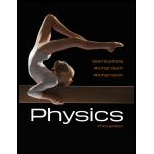
Concept explainers
(a)
The maximum current flows through the circuit.
(a)
Answer to Problem 58P
The maximum current flows through the circuit is
Explanation of Solution
Write an expression for the maximum current flows through the circuit.
Here,
Conclusion:
Substitute
Thus, the maximum current flows through the circuit is
(b)
The time taken for reaching the maximum current.
(b)
Answer to Problem 58P
The time taken for reaching the maximum current is
Explanation of Solution
Write an expression for the instantaneous current.
Here,
Rearrange equation (II) to find
Write an expression for the time constant.
Here,
Rearrange the equation (III) using equation (IV).
Conclusion:
Substitute
Thus, the time taken for reaching the maximum current is
(c)
The energy stored in the inductor and the rate at which energy is dissipated in the resistor.
(c)
Answer to Problem 58P
The energy stored in the inductor is
Explanation of Solution
Write an expression for the energy stored in the inductor.
Here,
The current is half of the maximum current. Thus, rewrite equation (VI).
Write an expression for the rate at which energy is converted in the resistor.
The current is half of the maximum current. Thus, rewrite equation (VIII).
Conclusion:
Substitute
Substitute
Thus, the energy stored in the inductor is
(d)
The maximum current flows through the circuit and the time taken for reaching the maximum current.
(d)
Answer to Problem 58P
The energy stored is
Explanation of Solution
Write an expression for equivalent resistance.
Here,
Write an expression for the maximum current flows through the circuit.
Write an expression for the time taken for reaching the maximum current.
Conclusion:
Substitute
Substitute
Substitute
Thus, the maximum current flows through the circuit is
Want to see more full solutions like this?
Chapter 20 Solutions
Student Solutions Manual for Physics
 College PhysicsPhysicsISBN:9781305952300Author:Raymond A. Serway, Chris VuillePublisher:Cengage Learning
College PhysicsPhysicsISBN:9781305952300Author:Raymond A. Serway, Chris VuillePublisher:Cengage Learning University Physics (14th Edition)PhysicsISBN:9780133969290Author:Hugh D. Young, Roger A. FreedmanPublisher:PEARSON
University Physics (14th Edition)PhysicsISBN:9780133969290Author:Hugh D. Young, Roger A. FreedmanPublisher:PEARSON Introduction To Quantum MechanicsPhysicsISBN:9781107189638Author:Griffiths, David J., Schroeter, Darrell F.Publisher:Cambridge University Press
Introduction To Quantum MechanicsPhysicsISBN:9781107189638Author:Griffiths, David J., Schroeter, Darrell F.Publisher:Cambridge University Press Physics for Scientists and EngineersPhysicsISBN:9781337553278Author:Raymond A. Serway, John W. JewettPublisher:Cengage Learning
Physics for Scientists and EngineersPhysicsISBN:9781337553278Author:Raymond A. Serway, John W. JewettPublisher:Cengage Learning Lecture- Tutorials for Introductory AstronomyPhysicsISBN:9780321820464Author:Edward E. Prather, Tim P. Slater, Jeff P. Adams, Gina BrissendenPublisher:Addison-Wesley
Lecture- Tutorials for Introductory AstronomyPhysicsISBN:9780321820464Author:Edward E. Prather, Tim P. Slater, Jeff P. Adams, Gina BrissendenPublisher:Addison-Wesley College Physics: A Strategic Approach (4th Editio...PhysicsISBN:9780134609034Author:Randall D. Knight (Professor Emeritus), Brian Jones, Stuart FieldPublisher:PEARSON
College Physics: A Strategic Approach (4th Editio...PhysicsISBN:9780134609034Author:Randall D. Knight (Professor Emeritus), Brian Jones, Stuart FieldPublisher:PEARSON





